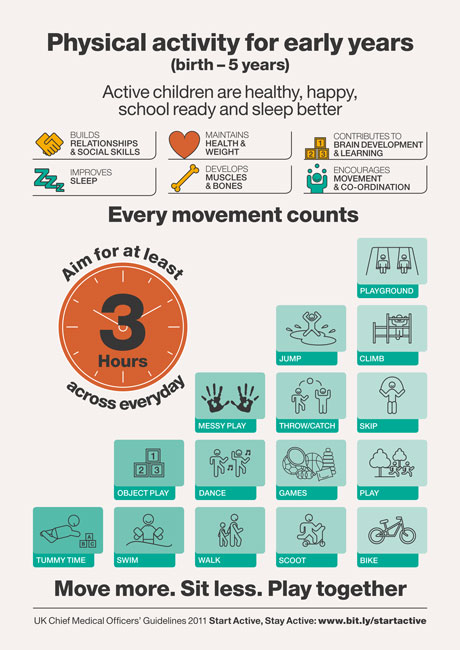
Alarming statistics show only one in 10 children aged two to four is active for the minimum recommended amount of time.
The UK’s chief medical officers (CMOs) first published recommendations for physical activity in 2011, but still very few children are active enough, a fact that has inspired the publicity drive and information graphic (below) aimed at parents and early years professionals.
The list of suggested activities would appear to cover most things besides sitting watching television, with crawling, walking, ‘tummy time’ and messy play featuring.
The premise is that ‘active children are healthy, happy, school ready and sleep better’.
Linda Baston-Pitt, a member of the expert group set up to help the UK CMOs to develop the infographic, said, ‘Currently, only nine per cent of children aged two to four meet the guidelines, and 84 per cent are active for less than an hour a day.
‘Early years settings provide an ideal opportunity to help every child establish lifelong healthy habits to take with them into their school years.
‘However, unless we have a greater focus on the importance of physical activity to ensure that every child has access to high quality physical opportunities from birth, we will fail our youngest citizens.’
The soon to be published childhood obesity strategy will tie in with the campaign, having drawn on the expertise of a wide range of groups, from the early years sector to food growers.
Ms Baston-Pitt said, ‘The childhood obesity strategy is soon to be published and is likely to focus on both healthy eating and physical activity.
‘We need to take positive action now working together to build on and share the wealth of knowledge and good practice within the EY sector to ensure a joined up approach.’

Posters and leaflets bearing the graphic will be available in health centres and settings, with the hope of initiating conversations around physical activity between practitioners and families.
The CMO guidelines, titled Start Active, Stay Active, were the first time that England, Wales, Scotland and Northern Ireland had the same ones.
The campaign stepped up recently rather than immediately at the time of publication in 2011, when health and education budgets were being cut, according to Ms Baston-Pitt.
She said, ‘The guidelines and planned follow up activity got overlooked and left behind.
‘On a positive note there is renewed focus and it is now being picked up.
‘Better late than never.’
The recommendations cover all age groups across the lifespan and for the first time included guidelines for early years.
Although there is limited research exploring the health consequences of sedentary behaviour in children under five, there is emerging evidence associating such early habits with becoming overweight, as well as lower cognitive development.
Long periods spent in pushchairs or highchairs appear to be contributing to low rates in the under-fives age group, said Ms Baston-Pitt.
There is also a lack of understanding and awareness of the activity needs of young children, she added, pointing out that many practitioners have received ‘minimal training and there are few opportunities for professional development’.
‘There is considerable expert opinion from many international sources that letting children crawl, play and roll around on the floor in the home or childcare setting is essential during the early years, particularly for children who cannot yet walk,’ she added.
‘For this age group, it is the amount and nature of activity that is important, not the intensity.
‘Physical activity can be accumulated throughout a whole day and suits the intermittent nature of children’s play of this age.
‘It also helps to break up too much sitting time.’









